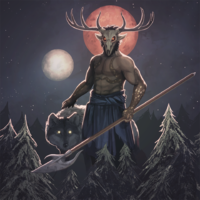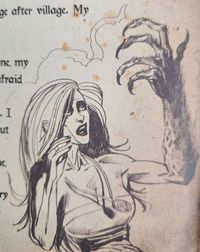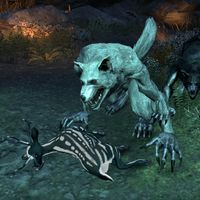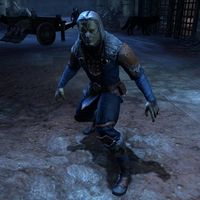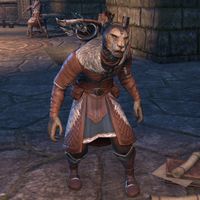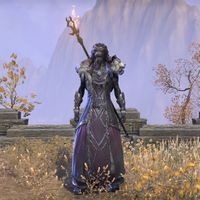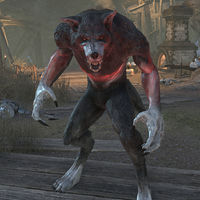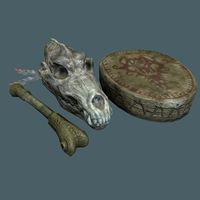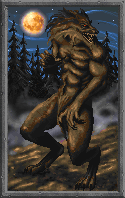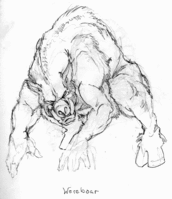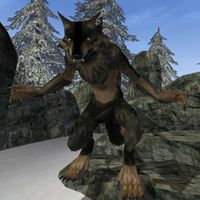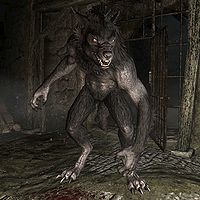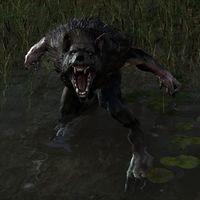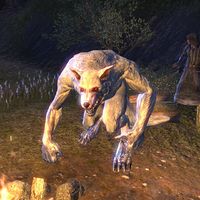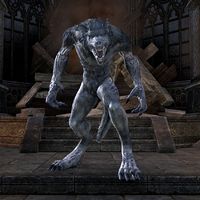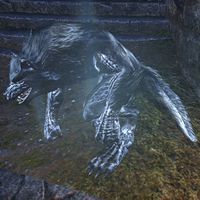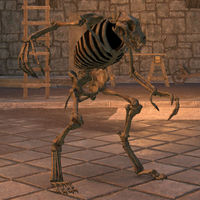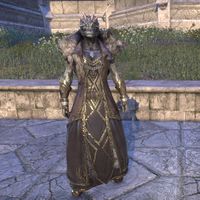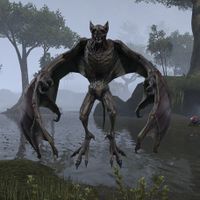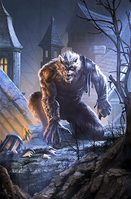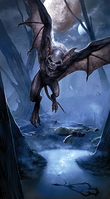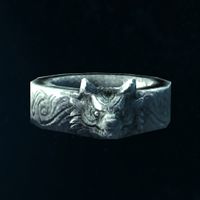Lore:Lycanthropy
Lycanthropy is a supernatural condition that causes a person to transform into a werebeast. Also known as werethings, werecritters,[1] were-creatures,[2] manbeasts,[3] skin-changers,[4] and skinshifters[5], these individuals are an unnatural cross between a beast and their original race. Lycanthropy is a disease[6] that seeps into the spirit.[7]:243 It is known as Hircine's Gift by those that view it as a blessing,[8] and Hircine's Curse to those that see it negatively,[9] Lycanthropy is contagious, and not selective about who it afflicts. Due to the dangerous and bloodthirsty nature of lycanthropes, those with the condition have been hated and feared through much of Tamriel's history. There are several known strains of this condition, most of which are specific to certain regions of Tamriel. However, the most common strain—which causes the afflicted to turn into a werewolf—is known to occur across the whole continent. Those who are infected with lycanthropy are referred to as "lycanthropes". They are also occasionally referred to as "lupines" or "loups".[10] Strictly speaking, the word "lycanthrope" should only refer to men who change into wolves, but it has long been used to refer to anyone who undergoes a similar beast transformation.[6]
Like vampirism, lycanthropes are able to spread their condition by transmitting a disease, which progresses to full-blown lycanthropy within a few days if left untreated. For instance, Sanies Lupinus can be contracted from werewolves, and over time will convert the afflicted into a werewolf.[11] Transmission seems to be brought about through being wounded via the claws or teeth of werebeasts; however, since most victims are killed, transmission occurs less commonly out in the wild. The surest way to pass on the curse is to drink the blood of the lycanthrope. Doing so immediately converts the one who partakes in the blood into a lycanthrope.[12] The first transformation occurs within moments, and is unusually intense.[13][14] A lycanthrope's form is dictated by the strain of lycanthropy contracted by the victim. Argonians will turn into furry werewolves if they contract Sanies Lupinus, just like the other Tamrielic races.[14][11][15][16]
Origin[edit]
Lycanthropy was originally created by the Daedric Prince Hircine, who bestows it as a "blessing" upon devotees and great hunters, hence why it is sometimes referred to as Hircine's Gift.[8] As Hircine is the Father of Manbeasts,[17] lycanthropes are considered his children,[18] and he serves as their guardian.[2] Hircine is quite proud of lycanthropy. He resents those who received his gift willingly but have come to regret it, and thus may task people with slaying his unappreciative children to put them out of their misery.[19] Regardless of whether they worshipped him or not, Hircine will typically claim the souls of werewolves, and they will spend eternity in the Hunting Grounds.[20]
Hircine is rumored to have unleashed the curse of lycanthropy upon Nirn early in history, with the earliest accounts being in the early Merethic Era.[21] A tale goes that Hircine meddled with the nature of wolves, making them susceptible to shapeshifting. This modification is the origin for both werewolves, and the Wild Hunt Wolf, who as their name suggests, are wolves that have become unraveled because they have forgotten their Y'ffre-taught form,[22] much like creatures that get caught up in the Bosmer’s Wild Hunt ritual.[23]
These first select few that were personally blessed by Hircine himself are known as the first turned, and are comparable to Molag Bal's Daughters of Coldharbour. These individuals would pass down their gift, and their chosen would follow suit, leading the condition to spread throughout Tamriel.[UOL 1] According to a legend,[2] lycanthropes were already being hunted down by Thane Icehammer during the reign of Hoag Merkiller.[24] Followers of Hircine can ritually bestow this blessing upon others, and can even replace vampirism with lycanthropy, as the two conditions are mutually exclusive.[13]
Unlike Molag Bal, Hircine maintains an active role in his creations' existence. He has been known to personally enhance favored lycanthropes with heightened abilities, and rewards some with powerful artifacts. An example of one of these tangible boons is the Ring of Hircine, which allows a lycanthrope to control their transformations.[25]
Cultural Perception of Werewolves[edit]
Lycanthropes are almost universally despised. Those with control over their condition may be treated in any number of ways. They may be respected by groups who pay heed to Hircine,[26] uneasily tolerated or shunned,[16][14] or even killed on sight.[27][28] The people of Skyrim rub canis root on neighboring trees and fences to keep werebears at bay.[6] There are also several signs to look out for when werewolves are suspected to be around: if wolves can be heard howling when there are none to be found, or strange animal tracks that suddenly disappear are present, werewolves may be in the area.[29]
During the Interregnum, Imperial soldiers were advised to turn themselves in to their superiors for immediate execution if they became infected with lycanthropy.[29] In Bosmer society, taking on the form of beasts is strictly forbidden by the Green Pact.[30] Wood Elves who deign to change their shape may be condemned to the formlessness of the Ooze.[31] Because of the dangerous and unpredictable nature of lycanthropes, they are more feared than vampires in some circles.[32]
Due to their reverence for Hircine, it is not uncommon to find lycanthropes among the Reachmen.[33] In a similar vein to Briarhearts, lycanthropy is viewed by most Reachfolk as self-sacrifice. Some texts indicate that it is seen as more of a useful condition rather than a gift, one which is suffered so the individual can better serve their clan.[26] Other texts describe it as a gift, and Reach Clans have proven zealous about the gift, as conflicts between them and the Viridian Wyrd have been reported.[34][35] Many of the Reachfolk's greatest champions are lycanthropes; they function as guardians and protectors of their clans.[4]
Individuals that specialize in tracking down and killing lycanthropes are known as werewolf hunters. These may work alone or in small groups,[36] or they may be part of a larger organization dedicated to wiping out lycanthropy. Such groups include the Death Hunters,[37] Order of the Silver Dawn,[38] the Silver Hand,[39] and the Vigilants of Stendarr.[40] Some people use perfume distilled from werewolf musk as a cosmetic fragrance, but it can also be used to avoid prowling werewolves.[41]
There are a few rare families in which lycanthropy is a hereditary condition. The disease can remain dormant for generations, only to spontaneously reassert itself in later descendants. Great crusades against lycanthropes are ultimately futile, unless the families who carry this bloodline are exterminated as well.[12]
The Skaal of Solstheim believe mummified wolf paws which are capped at the ankle with silver can ward away werewolves.[42] They also have spells they can use to detect traces of lycanthropic infection in the wake of a werewolf attack. These spells allow shamans with the knowledge to use them the ability to tell who is infected with a lycanthropic disease. However, the spell's sight only extends to those infected with the disease, not those who have already become werewolves.[43] The Skaal believe that lycanthropes are a perversion of natural order. They believe that Man was not meant to live a dual life as both rational being and animal.[44]
Symptoms and Effects[edit]
Several symptoms can be displayed in those infected with lycanthropy. The afflicted may be plagued by vivid nightmares, and the wounds they received from their lycanthropic attacker may be deep and visible.[29] Those infected with Sanies Lupinus may find themselves running into wild creatures, suffering strange injuries, or feeling drowsy before suddenly experiencing their senses sharpening.[8] While not transformed, werewolves may find that they've grown more hair in unexpected places, such as their ears.[45] Werewolf claws grow rapidly,[46] and their fur has a tendency to become matted.[47]
The most important and obvious effect of lycanthropy is the beast transformation itself. While in beast form, the lycanthrope has increased height and altered proportions, with one strain being recorded as having increased shoulder width, lengthened arms, narrowed hips and increased leg height.[48] The physical alteration grants the werebeast enhanced strength, speed, resilience, and stamina, as well as enchanted claws that can harm creatures that are immune to conventional weaponry.[6] Lone werewolves are almost never far from their pack; engaging them alone is a grave mistake. A werewolf's howl can not only call other werewolves to the beasts' aid, it can call forth regular wolves and bears as well.[36] Werebeasts are affected mentally as well, as they experience intense bloodlust.[49] In extreme cases, the victim experiences difficulties remembering what they did while transformed, or they become delirious.[citation needed] Werewolves who starve themselves can turn feral, putting them at risk of being unable to control their base impulses should they encounter a mortal. Starving werewolves may kill impulsively or find their self-control is only restored when their hunger is sated.[27]
Lycanthropes are commonly believed to have an aversion to specific herbs. Canis root is believed to ward off werebears,[6][29] while wolfsbane and belladonna are both known to be poisonous to werewolves,[48] and are used as components of remedies for the disease.[50] The juice of ripened belladonna berries causes a werewolf's veins to shrivel, and wolfsbane petals render their bones brittle.[48] Poisons and silver weapons are also considered especially effective against werewolves.[29][18][51] Even the weakest of poisons are effective against towering werebeasts.[18]
The circumstances of the transformation seem to vary wildly between individuals or strains of lycanthropy. Some lycanthropes transform every full moon,[14] while others transform every night.[28] Others seem able to choose when they transform, and some have the ability to resist transforming entirely.[52] The strength of a lycanthrope's bloodlust also varies. Some individuals experience an uncontrollable desire to kill, and others are able to maintain nearly complete control during a transformation. In the worst cases, an individual who lacks the willpower to control a transformation may turn feral, becoming little more than a mindless beast.[53] Generally, werebeasts do not revert to their original form upon death,[6] but there are some exceptions to this rule.[54]
A few effects of lycanthropy are present outside of transformation. The aforementioned bloodlust being a notable instance, as even in human form, the afflicted may still feel the desire to hunt and kill. Lycanthropes are immune to all diseases, and experience fitful sleep. They also may retain subtle physical traits outside of beast form, such as scents, or small patches of fur.[15] Lycanthropy also has spiritual effects that persist after death. Most lycanthropes go to Hircine's Hunting Grounds after death, rather than the afterlife they would otherwise have received.[52][20] However, this doesn't always seem to be the case. A priest from the Cult of the Ancestor Moth who lived during the Interregnum described the notion of Hircine "claiming" the souls of all lycanthropes as "poetic and misleading", stating that mortals decide the destinations of their own souls through the choices they make in life.[55] A notable example of werewolves who were directed somewhere other than the Hunting Grounds is the werewolves who served King Styriche as soldiers in the Gray Host. The entire Gray Host, including its werewolves, were damned to Coldharbour due to a pact Styriche made with Molag Bal.[56] Another notable example was Faolchu the Changeling, whose soul was pledged to Molag Bal when Angof the Gravesinger resurrected the werewolf in his conquest of Glenumbra.[57] After Faolchu's defeat, his soul was sent to Coldharbour, where he was punished by Molag Bal for his failure to keep the Lion Guard from retaking Camlorn.[58]
Hircine can grant great power and control over lycanthropy to favored worshipers. These boons are usually granted by specific artifacts, such as the Ring of Hircine. Additionally, those favored by Hircine may be granted the ability to transform entirely into a beast as opposed to a werebeast. For example, Hircine's Packmaster has the ability to transform into a wolf rather than a werewolf.[59]
Circa 2E 582, the Gray Host developed a mysterious disease to target rogue werewolf packs in Blackreach. The incubation of this disease is known to vary between individuals.[60] The disease forces a lycanthrope into their beast form and drives them feral as their minds degrade. The victims of this disease lose their mind and the ability to control their transformations.[60] One of the most dangerous effects of this disease is that it is contagious; those who are near someone with this infection can become infected themselves. An alchemist named Rasir was able to create a cure for the ailment, which had been devastating the Dark Moon Grotto werewolf refugee community.[61]
Werewolf Subtypes[edit]
Lycanthropy can manifest in several different ways, some of which are distinct from traditional lycanthropes. Some lycanthropes don't need to transform to show their inner Beast.
Man-Beasts[edit]
Not much is known about Man-Beasts. Those afflicted with this condition appear beast-like, even when they are not in beast form.[62] Their bodies are covered in light brown fur, and they have orange eyes. Man-Beasts are observed to be more intelligent and less primal than those in beast form, and are able to cast spells and use weapons. They lurk in the shadows waiting for their victims, and have vicious claws for tearing at their prey.[62] The term man beast (without the dash) is used to describe werebeasts as a whole.[3]
Werewolf Lord[edit]
The Werewolf Lord is a powerful lycanthrope that maintains a humanoid form with bestial qualities. Unlike traditional lycanthropes, a Werewolf Lord's form blends racial characteristics of the individual with that of the wolf. An Argonian will still look like an Argonian, but with wolf-like features.[63] One of the most notable Werewolf Lords was Vykosa the Ascendant, who was so powerful that she could bend the will of other werewolves.[64] She was rumored to be one of the first werewolves, and was promised glory and power by Hircine.[65]
Werewolf Behemoth[edit]
The Werewolf Behemoth is a powerful werewolf which is granted a hulking form and even greater strength than their smaller counterparts. Ordinary werewolves can become behemoths through alchemical alteration. They can also come naturally through Hircine, but only the most esteemed hunters are granted this gift.[66] Vykosa's underling Ernarde was able to reproduce this during his experiments in 2E 582. Through countless injections and tireless spellcraft, Ernarde was able to transform the members of the Moon Hunter Pack. His efforts granted existing werewolves amplified strength and size, allowing them to become unstoppable warriors should they survive the transformation.[64] Ernarde's efforts were not the only source of titanic werewolves during this point in time. Powerful werewolves with the Gray Host were also able to transform into behemoths.[67] The mad alchemist Arkasis created potions that allowed non-lycanthropes, including vampires, to transform into werewolf behemoths.[68] These potions did not infect the subject with lycanthropy; rather, the concoctions simply granted the subject the form of a hulking monstrosity for a time. Those experiencing the effects of Arkasis's potions would temporarily be granted instincts similar to real werewolves.[69]
Curing the Condition[edit]
It is well known that lycanthropy can be prevented by curing the disease that causes it, which must be done before the subject's first transformation. After this point, it becomes extremely difficult to obtain a cure.[6][43] The witches of the Glenmoril Wyrd are the only beings known to have possessed cures of a conventional nature, potions and scrolls that are relatively free of side effects. Unfortunately, they seem to guard their secrets closely, and do not openly offer these cures.[12][50]
The Silvenar, being a living representation of the Green Pact that fixed the form of the Bosmer, has the ability to instantly cure Green Pact Bosmer who unwillingly contract lycanthropy.[70] In 2E 582, an alchemist from Camlorn successfully developed a cure for the strain of lycanthropy spread by Faolchu the Reborn, using blood from infected werewolves.[71]
Most cures require the lycanthrope to find a way to exorcise their inner beast. One example includes transmitting the condition to someone who already has dormant, hereditary lycanthropic genes. Infecting such a person will cause the one offering their blood to be cured due to the intensity of its blossoming in the victim.[12] Undergoing a ritual performed by the Glenmoril witches is another way to cure lycanthropy.[12] The witches sacrifice an innocent, infect the victim's flesh with the client's curse, and resurrect the sacrifice. The original lycanthrope must then kill the victim a second time, which will permanently destroy their inner beast.[50] A third method for curing lycanthropy involves using the magic from the head of a Glenmoril witch to summon one's inner beast as a spirit, then destroying that spirit.[72]
Finally, lycanthropy can be supplanted by vampirism. Under normal circumstances, this is impossible, because lycanthropes are immune to disease. However, a pure-blooded vampire can convert a lycanthrope into a vampire lord, instantly replacing Hircine's gift with that of Molag Bal.[73][74] In general, lycanthropes do not revert to their original form upon death,[6] but there may be some exceptions to this rule.[54]
Other Treatments[edit]
Aside from capturing, killing, or curing lycanthropes, there are few methods of preventing them from harming others if they are unable to control their lust for blood. The simplest solution is isolation.[49][75] Lycanthropes that live far from any settlements, especially when well fed, are less likely to harm other people. Despite their bloodlust, it seems that some lycanthropes can manage to live on a mostly plant-based diet. Those that do not wish to consume mortal flesh can resort to eating mere beasts. Those that cannot morally bring themselves to kill another living creature can subsist on recently deceased animals and carrion left by other predators.[49] Berries, nuts, and roots have been found in the stomachs of dissected werewolves, suggesting that they don't even need to consume manflesh to survive.[6] In fact, lycanthropes have an easier time finding food while transformed than they do in human form. While transformed, a werewolf's senses are so acute that they can detect food of all sorts.[49]
Another way lycanthropes can control themselves is to use the Ring of Hircine to grant control over transformation.[25] However, relatively few lycanthropes have ever been able to obtain the ring. A third, perhaps unique method, was employed by the werewolves of Kerbol's Hollow in the Second Era. There, an entire village of werewolves was bound together in a ritual that suppressed their bloodlust and transformations entirely, leading to the appearance of a cure.[76] However, this state was fragile, since if an initiate were to transform, the spell would be broken.[77] Furthermore, the ritual had troubling side effects, as it subjected the minds of those affected to the will of the caster and changed their personalities.[78] The mayor kept a jug filled with blood for emergencies.[79]
Known Lycanthropic Strains[edit]
| Name | Area | Notes |
|---|---|---|
| Werebat | Valenwood | Werebats formed part of the Gray Host, and were seen living near the Keerilth vampire clan within Shademist Moors in 2E 582.[80][81] Not much else is known about them. |
| Werebear | Skyrim, northern Cyrodiil, northern High Rock, northern Morrowind,[6] Solstheim | They are the second most common lycanthrope in Skyrim.[82] |
| Wereboar | Hammerfell and High Rock | They find the climates of High Rock and Hammerfell to be amenable.[6] Usually found in the Iliac Bay region. |
| Werecrocodile | Black Marsh and southern Morrowind | Known to lurk in isolated swamps.[6] |
| Werelion | Elsweyr, Black Marsh, and Cyrodiil | They can be found in the wetter parts of these regions.[6] |
| Wereshark | Unknown | No primary sources exist that confirm the existence of weresharks, though the author of On Lycanthropy asserts that his peers say they do exist.[6] |
| Werevulture | Valenwood | According to Lentulus Inventius of the Order of the Thorn, they were enough of a threat in Valenwood that he sought out werebears to help deal with the issue, lest the werevultures became a threat to other areas of Tamriel.[82] |
| Werewolf | All areas of Tamriel | The most common form of lycanthrope. |
Werewolf Packs[edit]
—Majni
Werewolves commonly form packs apart from the rest of society. This makes them a more formidable opponent for werewolf hunters,[36] and also gives them the opportunity to satisfy their instinct to hunt together. Werewolf packs have a hierarchy with an alpha or a den mother at the helm.[83][84] Werewolves tend to have a respect for the pack hierarchy, and may be compliant with aggressors if their leader is held hostage.[85] Werewolf packs are notoriously territorial, often engaging in bloody conflicts over land.[84]
Hircine himself designates a Packmaster for the Pack that resides in the Hunting Grounds. The Packmaster is granted power beyond other werewolves when they are chosen, and are as much a wolf as they are a man.[59] Werewolves who wish to join this Pack must meet with the Packmaster and undergo a ritual to gain Hircine's blessing. The initiate must hunt a worthy beast and call for the Pack to feast with them before they are welcomed into the fold.[86]
Several werewolf packs have risen and fallen throughout Tamrielic history. Some live in peace, while others prefer to prey on people. The Magnar Pack was an example of the latter. Magnar Bearstorm, also called Magnar Child-Eater was the pack's Alpha. He had a taste for the tender flesh of children, and rewarded pack hunters for acquiring countless people. The Silver Dawn was quite literally at war with the Magnar Pack in 2E 582, with both sides accruing a large number of casualties.[38] By that time, Magnar Child-Eater had ruled the greater Wrothgar pack for at least fifty years.[87] The Magnar Pack nearly won this war when they tracked a member of the Order to their base of operations at the Argent Mine, a silver mine which helped the Order's founder accrue great wealth in the Order's early days.[38][88] The Pack killed every member of the Silver Dawn they found within, but were unable to eradicate the Order in its entirety.[89]
The Thornfang Pack's den mother made the decision to relocate the pack to Summerset Isle in 2E 582. Despite the fact that werewolves are outcasts in Summerset's strict purist society, the Altmer lacked experience in dealing with lycanthropes, making this move a tactical decision. On top of that, there were no other packs on Summerset at the time, meaning the Thornfangs wouldn't have to compete for prey or territory. The pack decided to strengthen its numbers by abducting travelers off the road and turning them.[84] The werewolves of the Thornfang Pack often collected and embellished the skulls of their most impressive kills.[90]
Werewolves were rare on Solstheim in the Third Era, but saw resurgence in 3E 427 with the approach of the impending Bloodmoon Prophecy.[44] By 4E 201, the Frostmoon Pack persisted on the island. The pack lived near Frostmoon Crag, and competed with the local werebears for territory.[91] Their packmaster, Majni, claimed the Frostmoon Pack was the "last true pack that remained".[92]
Related Artifacts[edit]
Rings[edit]
Hircine's Ring can give those afflicted with the disease more control over their powers. In some incarnations, it has the ability to prevent a monthly transformation, and allows the lycanthrope to transform as often as they'd like.[93][94] It has also been used to transform people who aren't infected with lycanthropy into werewolves.[95] Hircine once cursed this artifact to have the opposite effect; the wearer would transform at random and unpredictable times, until the curse was lifted.[25][96]
Other blessed rings are known to exist that can enhance beast forms. Once used in the Bloodmoon Prophecies, they are still possessed by the Frostmoon Pack of Solstheim.[92][97]
Totems[edit]
The Totems of Hircine are said to date from prehistoric times, before even speech was developed.[98] Each one grants a special power to any lycanthrope who possesses and reveres the item.
There are three known totems:[98]
- Totem of Terror
- A carved wolf skull, which enhances the lycanthrope's power to inspire terror.
- Totem of The Hunt
- The carved thigh bone of an unknown animal, which enhances the lycanthrope's senses.
- Totem of Brotherhood
- A simple drum, which gives the lycanthrope the ability to call allies.
The Hunting Grounds[edit]
Upon death, lycanthropes go to Hircine's Hunting Ground to hunt with him for all eternity.[18] The Hunting Grounds are considered by some lycanthropes to be an ideal afterlife, but others feel that this denies them a true paradise.[52] The realm is made up mostly of dense woodland and vast grasslands and plains, as well as blood-red tributaries. Mortals entering these realms are typically hunted down by the inhabitants. During the day, werebears hunt the inhabitants, and at night, Hircine announces himself with a pack of werewolves.
History[edit]
Werewolves have played a role in several historical events. The Order of the Silver Dawn was founded in 2E 428, during one such event: the Curse of the Crimson Moon, a werewolf crisis that plagued High Rock during the Second Era.[38] Around 2E 577, the mad alchemist Arkasis of Whiterun terrorized three of Skyrim's Holds. He conducted unspeakable experiments on unwilling test subjects. Each Hold had its own legend about the alchemist, but in every tale, the experiments involved strange alchemical substances and horrific transformations. With each crime, Arkasis eluded capture, and grew more bold until he was inevitably exposed in Whiterun in 2E 577. During Arkasis's reign of terror, the howling of wolves preceded nightly disappearances. Tensions hit a peak when a member of the Battle-Born family was found naked, covered in blood, and surrounded by dead livestock on the Gray-Mane estate. Accusations of lycanthropy were thrown around and several people called for executions, sparking a feud between the Battle-Borns and the Gray-Manes. A stranger offered to investigate, and found neither clan was at fault. The jarl and the court alchemist both disappeared under mysterious circumstances, leading the newly ascended Jarl Morryn to declare Arkasis a menace of the highest order.[69]
Also of note, many werewolves were part of the Gray Host, the undead army lead by King Styriche of Verkarth. Styriche's pact with Molag Bal doomed the Gray Host, including its werewolves, to Coldharbour in death.[56] In 2E 582, the Host's last surviving leader joined forces with the Icereach witch coven to bring the Gray Host back to Tamriel. Powerful Harrowstorms were whipped up, and the Host's werewolves were among those resurrected by the innumerable soul sacrifices that took place during the storms.[67]
Werewolf populations saw a boom around Skyrim in 2E 582. The Companions received reports of individuals who actively sought to be cursed with lycanthropy.[18] That same year, Faolchu the Changeling was resurrected by the Bloodthorn Cult. Faolchu captured Camlorn with his army of werewolves, ousting or killing the city's Breton inhabitants. He didn't get to enjoy Camlorn Keep for long, as he was defeated by the Lion Guard later that year.[99]
Important Lycanthropes[edit]
- Arienne Kerbol — A Breton mayor who mentally enslaved the residents of Kerbol's Hollow in order to suppress their lycanthropy.
- Bradan — A Reachfolk leader of the remnants of the Ghostsong Clan and prominent member of the Wayward Guardians.
- Faolchu — A general in the Alessian Order.
- Songamdir — Hircine's Packmaster in 2E 582; he was granted the ability to turn into a wolf.
- Terrfyg — The Harbinger that started the tradition of lycanthropy in the Companions, which persisted after his death.
- Tharsten Heart-Fang — The leader of the Skaal at the end of the Third Era. He was secretly a werewolf.
- Exarch Ulfra — A leader of the Gray Host.
- Ulthorn the Hound — A werewolf who desired to take the Green Lady Gwaering for himself and away from the rightful Silvenar.
- Vykosa — One of the first werewolves.
See Also[edit]
- For game-specific werewolf and lycanthropy information, see the Daggerfall, Morrowind, Skyrim, and ESO articles.
Books[edit]
- An Accounting of Werewolves by Sage Svari ofFallowstone Hall — An essay regarding werewolf encounters in Skyrim
- A Cure for Lycanthropy by Archivist Ernarde of the Silver Dawn — A lycanthropy researcher's journal
- History of the Handfast — A poem dedicated to the anointment ritual and wedding of the Silvenar to the Green Lady
- Lakewatch Tower — The tale of Garach Wolf-Father
- Living with Lycanthropy — Guidance on living a productive, peaceful life while afflicted with Lycanthropy
- Lycanthropic Legends of Skyrim by Lentulus Inventius, Order of the Horn — A recounting of the unwillingness of Skyrim's inhabitants to share stories of Lycanthropy
- On Lycanthropy by Varnard Karessen — Studies of the nature and habits of Lycanthropes
- Physicalities of Werewolves by Reman Crex — A morbid anatomical study of werewolves on live subjects
- A Werewolf's Confession by Captain Philmont of the Oldgate Lancers, Daggerfall Covenant Army — The confessions of a regretful lycanthrope
- Werewolves: Long-Suffering Guardians by Brigwoal, Reach warrior
Transcribed by Zamshiq af-Halazh, Associate Folklorist at the University of Gwylim — Lycanthropy from the point of view of a Reachman Werewolf - The Werewolf's Hide by an Unknown Packleader — A werewolf's greatest asset
Notes[edit]
- According to the 16 Accords of Madness, v. VI, Hircine once imbued a Daedroth with lycanthropy to fight in a duel with a creature of Sheogorath's making. There are no other mentions of such Daedric lycanthropes, however.
- According to Lord Archibald Laurent's writings it is possible that vampire-lycan hybrids exist. Though whether he meant this exactly, or was referring to a literal pair of two cursed individuals is unknown.[100]
Gallery[edit]
References[edit]
- ^ Hunt for a Lycanthrope in Daggerfall
- ^ a b c Legend of Thane Icehammer
- ^ a b The Four Abominations — Vinicius Imbrex, Archbishop of Chorrol, 1E 1051—1087
- ^ a b Arana's dialogue during The Awakening Darkness in ESO
- ^ Aspects of Lord Hircine — Juno Procillus, Academy of Chorrol
- ^ a b c d e f g h i j k l m n On Lycanthropy — Varnard Karessen
- ^ The Elder Scrolls V: Skyrim: Prima Official Game Guide#Legendary Edition — David Hodgson
- ^ a b c Thoreki's dialogue during Hircine's Gift in ESO
- ^ Wanted: Nimriian the Longfang
- ^ Additional Dialogue for Hunt for a Lycanthrope in Daggerfall
- ^ a b Events of Bloodmoon
- ^ a b c d e Events and dialogue during Cure for Lycanthropy in Daggerfall
- ^ a b Events of The Silver Hand in Skyrim
- ^ a b c d Werewolf transformation mechanics in Daggerfall
- ^ a b Werewolf transformation mechanics in Skyrim
- ^ a b Werewolf transformation mechanics in ESO
- ^ The Book of Daedra
- ^ a b c d e An Accounting of Werewolves — Sage Svari ofFallowstone Hall
- ^ Events of Hircine's quest in Daggerfall
- ^ a b Hanu's dialogue in ESO: Wolfhunter
- ^ Sage Svari Answers Your Questions — Sage Svari
- ^ Wild Hunt Wolf mount description in ESO
- ^ Wild Hunt Crown Crate season description in ESO
- ^ Loading screen text for Icehammer's Vault
- ^ a b c Sinding's dialogue during Ill Met By Moonlight in Skyrim
- ^ a b Great Spirits of the Reach: Volume 2 — Vashu gra-Morga, Chief Daedrotheologist at the University of Gwylim
- ^ a b A Werewolf's Confession — Captain Philmont of the Oldgate Lancers, Daggerfall Covenant Army
- ^ a b Werewolf transformation mechanics in Bloodmoon
- ^ a b c d e Dealing with Werewolves — Venustinius Perquitienus
- ^ The Green Pact and the Dominion
- ^ The Ooze: A Fable
- ^ Vampire-Related Skyrim Loading Screen text
- ^ The Improved Emperor's Guide to Tamriel: Northern Bangkorai and the Mountains — Flaccus Terentius, 2E 581
- ^ The Glenmoril Wyrd — Lady Cinnabar of Taneth
- ^ The Heart of the Beast quest in ESO
- ^ a b c A Werewolf Hunter's Advice
- ^ Death Hunters faction in ESO
- ^ a b c d Purifier's Journal — Purifier Cyrus
- ^ Aela the Huntress's dialogue during The Silver Hand in Skyrim
- ^ Vigilant of Stendarr NPC dialogue in Skyrim
- ^ Werewolf Musk Oil item description in ESO
- ^ Gnarled Paw item description in ESO
- ^ a b Korst Wind-Eye's dialogue during The Siege of the Skaal Village in Bloodmoon
- ^ a b Korst Wind-Eye's dialogue on the topic of werewolves in Bloodmoon
- ^ Guard Dialogue towards werewolves in Skyrim
- ^ Werewolf Claw Clippers item description in ESO
- ^ Werewolf Knot Rake item description in ESO
- ^ a b c Physicalities of Werewolves — Reman Crex
- ^ a b c d Our Curse and Our Glory — Querbolus Primus
- ^ a b c Events of Rite of the Wolf Giver in Bloodmoon
- ^ Ardanir's dialogue during To Burn Away Evil in ESO
- ^ a b c Kodlak's Journal — Kodlak Whitemane
- ^ World Interactions involving a farmer killing his wife in Skyrim
- ^ a b Events of The Beast in Daggerfall
- ^ The Abbot Crassius Viria Answers Your Questions — Abbot Crassius Viria
- ^ a b My Beloved Siblings, the Exarchs — Rada al-Saran
- ^ Angof the Gravesinger's dialogue during the quest Lineage of Tooth and Claw in ESO
- ^ Faolchu the Reborn's dialogue during the quest God of Schemes in ESO
- ^ a b Songamdir's dialogue during Hircine's Gift in ESO
- ^ a b Tranya's dialogue during Hounds of Hircine
- ^ Events of Hounds of Hircine in ESO
- ^ a b Sable Man-Beast skin description in ESO
- ^ Werewolf Lord Polymorph appearance in ESO
- ^ a b Log No. 321: Unexpected Results — Archivist Ernarde of the Moon Hunter Pack
- ^ The Hungry Cat's Curse — Vykosa the Ascendant
- ^ Exarch Ulfra's dialogue during The Gray Council in ESO
- ^ a b The resurrection of werewolves and Gray Host Wolflords at Harrowstorms in ESO: Greymoor
- ^ Werewolf Behemoth transformation mechanic within Stone Garden in ESO: Stonethorn
- ^ a b Meet the Character - Arkasis — Adandora, Chronicler-at-Large
- ^ Events of A Tale Forever Told in ESO
- ^ Events of Hidden in Flames in ESO
- ^ Events of Glory of the Dead in Skyrim
- ^ Harkon's dialogue during Bloodline in Dawnguard
- ^ Harkon's ability to turn the player into a vampire lord despite the player being a werewolf in Dawnguard
- ^ Events of Ill Met By Moonlight in Skyrim
- ^ Events of Freedom's Chains in ESO
- ^ Arienne Kerbol's dialogue during Freedom's Chains in ESO
- ^ Draven Leonciele's dialogue during Freedom's Chains in ESO
- ^ Kerbol's Blood Jug item description in ESO
- ^ Gray Host in ESO
- ^ Presence of Werebats near the vampires of Shademist Moors in ESO
- ^ a b Lycanthropic Legends of Skyrim — Lentulus Inventius, Order of the Horn
- ^ Adonatus Varian's dialogue during Moonlight Ascent in ESO
- ^ a b c The Pack of Archon's Grove — Gerrodroth of the Thornfang Pack
- ^ Lycanthropic Immunity — Exarch Tzinghalis
- ^ Events of Hircine's Gift in ESO
- ^ The True Nature of Magnar — Volas Night-Eyes
- ^ Letter to Purifier Cyrus — Scout Avaline
- ^ Dirdre's dialogue during Silver Linings in ESO
- ^ Indrik Skull Trophy item description in ESO
- ^ Hjordis's dialogue in Dragonborn
- ^ a b Majni's dialogue in Dragonborn
- ^ Effects of Hircine's Ring in Daggerfall
- ^ Effects of the Ring of Hircine in Skyrim
- ^ Effects of Hircine's Ring in Bloodmoon
- ^ Effects of the Cursed Ring of Hircine on werewolves in Skyrim
- ^ Effects of the Ring of Instinct, Ring of the Hunt, Ring of the Moon and the Ring of Bloodlust in Dragonborn
- ^ a b The Totems of Hircine
- ^ Events of The Fall of Faolchu in ESO
- ^ The Gray Host: A History Part 1 — Lord Archibald Laurent, Lordly Explorer
Note: The following references are considered to be unofficial sources. They are included to round off this article and may not be authoritative or conclusive.
- ^ Twitch Stream of The Elder Scrolls Online: Wolfhunter First Look, time stamp 16:34-17:02
|
||||||||||||||||||||||||||||||||||

